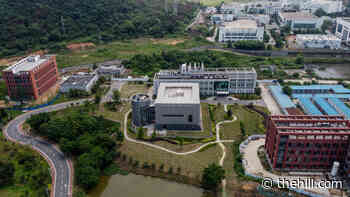
The media face hard questions amid a growing acceptance that it is possible COVID-19 originated in a Chinese laboratory.
The idea was disparaged as a conspiracy theory by multiple outlets last year — almost surely because its loudest promoter was then-President Trump.
Now, as uncertainty grows, there are burgeoning suspicions that the media overstepped their mark.
For conservatives and some media critics, that’s part of the larger issue of bias.
They argue, for example, that mainstream outlets have played down the severity of the crisis at the southwestern border under President Biden by comparison with the coverage the issue received under Trump.
On the voting rights debate, the conservative critique is that news organizations have glossed over tight restrictions in Democratic-dominated states in the Northeast while focusing on GOP strongholds in the South.
Amid liberal activist outrage over stricter early voting laws, for example, it is rarely noted that deep-blue Connecticut has no early voting at all, nor does it permit “no excuse” absentee voting.
Trump, naturally, has been doing a victory lap on the question of COVID-19’s genesis — despite the fact that the “lab leak” theory, as it has become popularly known, is merely within the realms of possibility rather than being anywhere close to proven.
“Now everybody is agreeing that I was right when I very early on called Wuhan as the source of COVID-19, sometimes referred to as the China Virus,” Trump crowed in a statement late Tuesday morning, repeating a term that critics have derided as racist because it can provoke violence against Asians and Asian Americans.
“To me it was obvious from the beginning but I was badly criticized, as usual. Now they are all saying ‘He was right.’ Thank you!”
It’s not clear that Trump was right, and in the early days of the pandemic, Trump allies had suggested that the deadly virus might have been manufactured by the Chinese as a biological weapon — an idea that is scorned by the vast majority of the scientific community.
In addition, Trump’s broad push to blame China for the virus often appeared to minimize the danger of the coronavirus.
Still, leading public health officials including Anthony Fauci now appear to acknowledge it’s possible the virus came from the Chinese lab. Fauci, who famously battled with Trump throughout the pandemic, says he’s not convinced the virus came about naturally.
Some independent and left-of-center figures are among those making the case that the media got the story wrong.
Liberal writer Jonathan Chait catalogued a number of media reports that had dismissed the lab leak theory in a column for New York Magazine earlier this week. Those claims now seem, at best, overstretched.
Both The New York Times and The Washington Post, for example, accused Sen. Tom Cotton (R-Ark.) of spreading a “conspiracy theory” when he called for more investigation of the lab leak theory. An NPR report said there was “virtually no chance” the thesis was correct. The fact-checking website PolitiFact called the idea that the virus was man-made a “debunked conspiracy theory” — a finding that it has recently retracted.
“It is true that most of these outlets were more faithful to the truth than Trump, whose gusher of lies vastly exceeded whatever false claims trickled out of the liberal media. But Trump is not the right standard for journalists,” Chait wrote.
In later exchanges on social media, Chait also took issue with those who would exculpate the media by suggesting they were simply reporting the scientific consensus of the time.
“This is wrong,” Chait tweeted in response to one such comment. “Reporters often imposed overly certain conclusions (‘conspiracy theory’) on much more hedged evidence from their own sources.”
The science surrounding the possible origins of COVID-19 is, unsurprisingly, complicated.
The most common thesis has always been that the virus jumped from some form of animal, most likely bats, to humans.
But it is at least circumstantially intriguing that the virus first emerged in Wuhan, China — the city that hosts an institution that has for years studied the larger family of coronaviruses, the Wuhan Institute of Virology (WIV).
The Chinese government has adamantly denied any culpability, as has the main scientist who directs the research.
Then again, that’s hardly surprising given Beijing’s penchant for authoritarianism and secrecy, and the fact that no scientist would be rushing to take responsibility for a virus that has killed about 3.5 million people worldwide.
The lab leak theory has recently gained pace for a number of reasons.
According to some reports — most prominently in The Wall Street Journal, though the story appears to have been broken by The Australian newspaper — three WIV researchers were hospitalized with COVID-like symptoms in November 2019.
On Monday, the Journal reported on a disused Chinese copper mine where six miners fell ill with a mystery ailment back in 2012. Three of the miners died.
“Chinese scientists from the Wuhan Institute of Virology were called in to investigate and, after taking samples from bats in the mine, identified several new coronaviruses,” the Journal noted.
Fauci’s remark that he was “not convinced” COVID-19 had occurred naturally sparked another boom in the cottage industry of Fauci criticism, given its apparent incongruity with comments from last year in which he said everything “strongly indicates” that the virus “evolved in nature and then jumped species.”
Naturally, the mounting uncertainty over the COVID-19 origin question is being weaponized on the nation’s polarized political battlefield.
Sen. Ron Johnson (R-Wis.) told Fox News on Tuesday that the lab leak had been “hidden in plain sight for literally months but the mainstream media just won’t pick it up.” The previous day, former Secretary of State Mike Pompeo told the same network he was “convinced” evidence would ultimately prove the lab leak theory true.
Again, most scientists still believe the virus occurred naturally.
The question is whether the media played down the element of doubt.
For now, the answer seems to be yes.
Even if they did so in part to overcorrect for an unusually mendacious president, they did themselves and the public no favors.
Via The Hill


